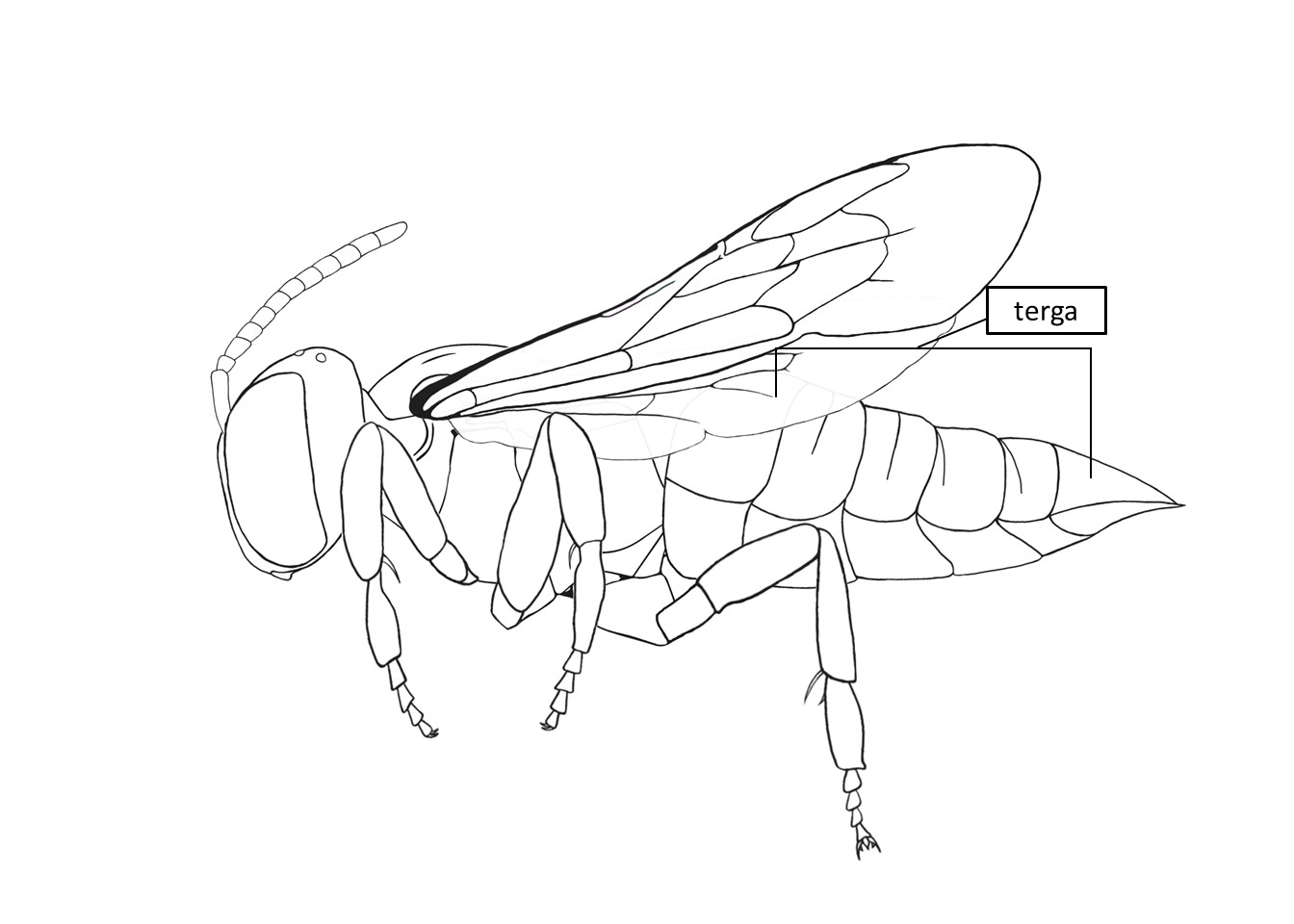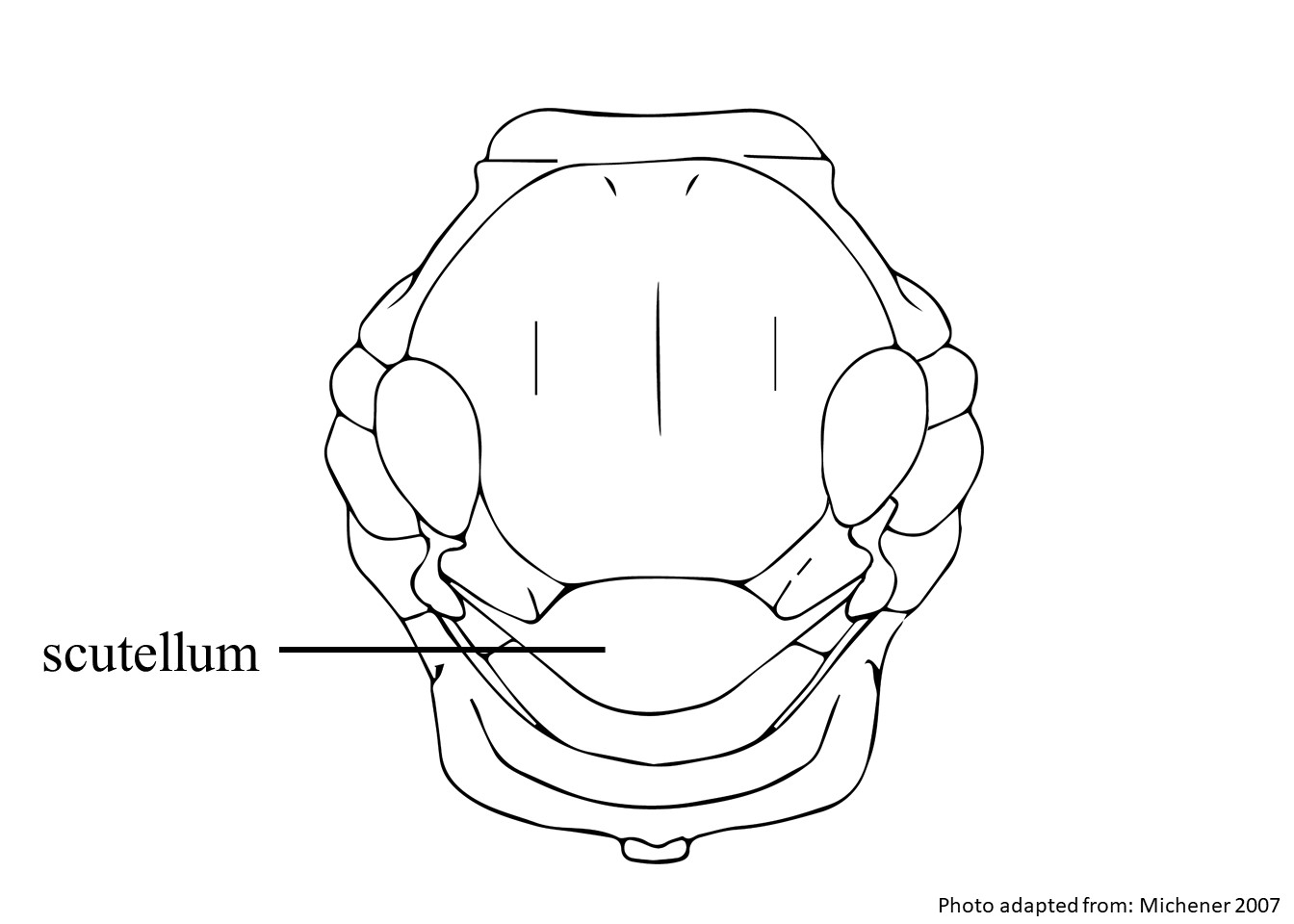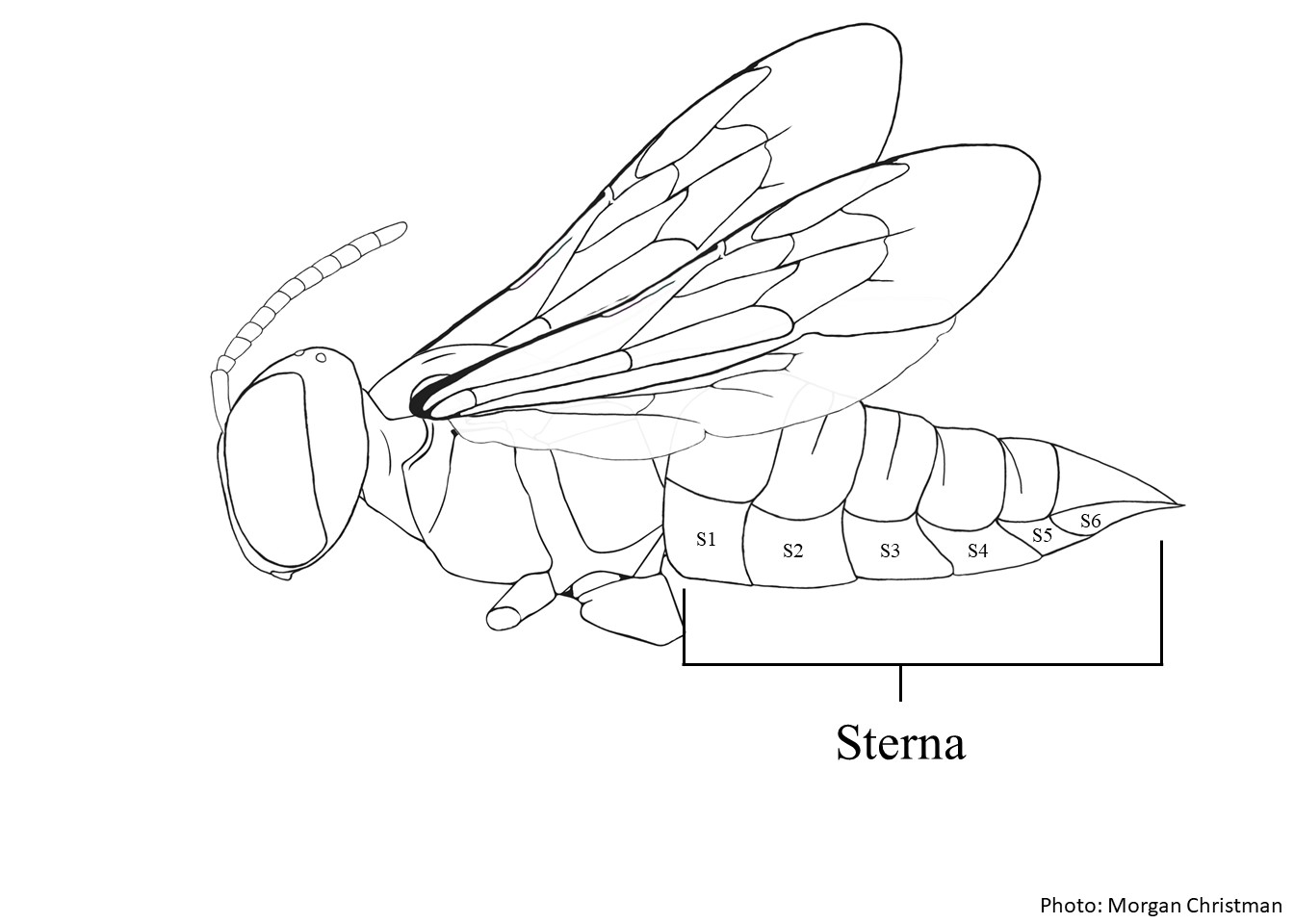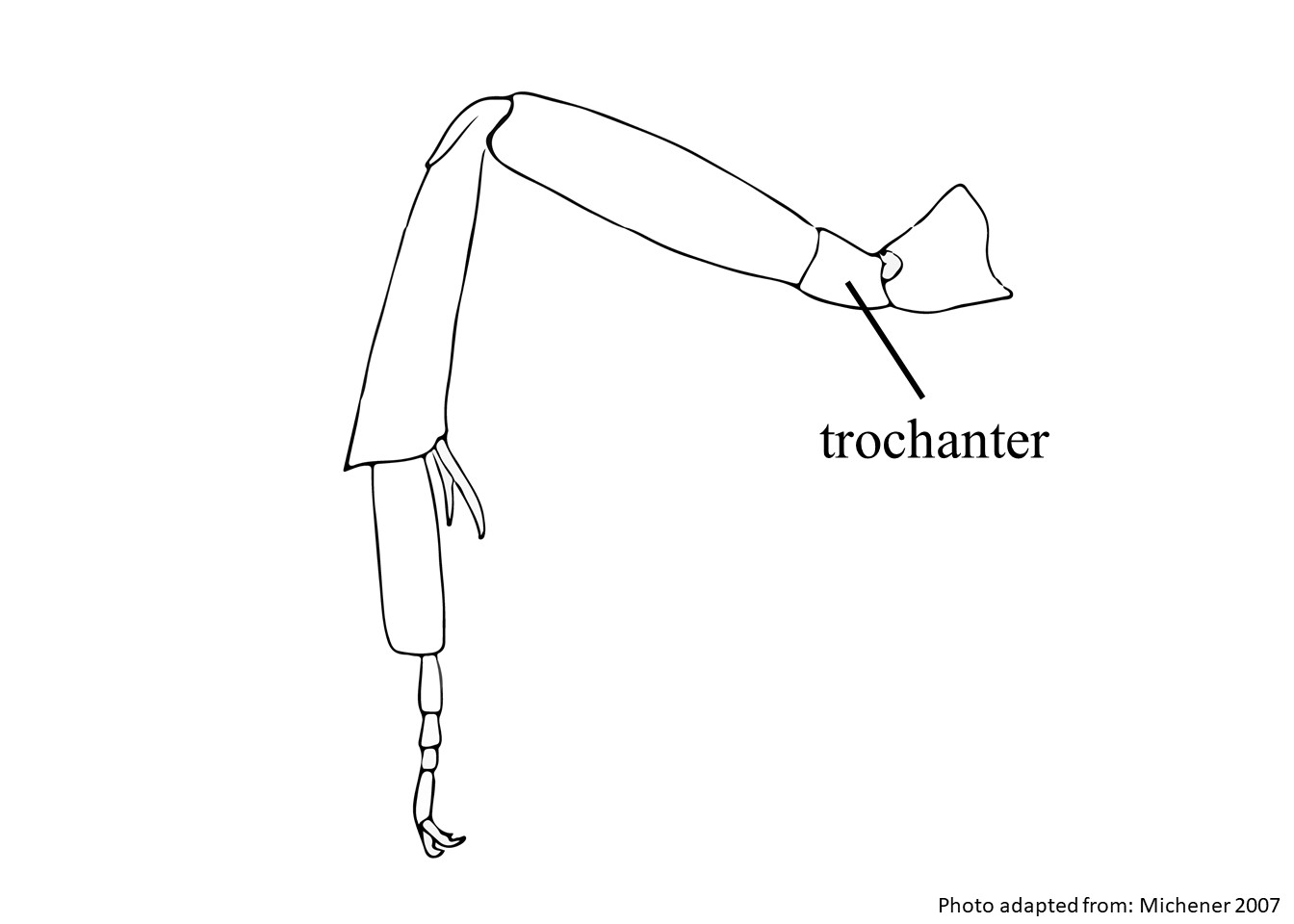Taxonomy
Family: Megachilidae
Subfamily: Megachilinae
Tribe: Anthidiini
Genus: Pseudoanthidium, Friese 1898
Subgenus: Pseudoanthidium, Friese 1898
Species: Pseudoanthidium tenellum (Mocsáry, 1880)
Background
Pseudoanthidium tenellum are relatively small, 6–9 mm bees. They have a predominantly black
integumentintegument:
a tough, protective outer layer
with symmetrical yellow markings on their face,
tergaterga:
the segments on the top side of the abdomen, often abbreviated when referring to a specific segment to T1, T2, T3, T4, T5, T6, or T7

, and often the
scutellumscutellum:
shield shaped plate behind scutum

. Their legs are yellow to orange and may be black at the base. The size of the yellow portions varies within the species. Males tend to have yellow mandibles and a larger yellow portion of their face. Females tend to have black mandibles and smaller yellow portions of their face. Both male and female specimens have a thin coat of white
pubescencepubescence:
short, fine hair
that covers most of their bodies. Their wings are translucent and sometimes slightly brown.
Distribution
Pseudoanthidium tenellum are known from Southern Europe through Central Asia (
Litman et al. 2021Litman et al. 2021:
Litman, J. R., Fateryga, A. V., Griswold, T. L., Aubert, M., Proshchalykin, M. Y., Le Divelec, R., Burrows, S. & Praz, C. J. 2022. Paraphyly and low levels of genetic divergence in morphologically distinct taxa: revision of the Pseudoanthidium scapulare complex of carder bees (Apoidea: Megachilidae: Anthidiini). Zoological Journal of the Linnean Society, 195(4): 1287-1337.)
Host associations
Pseudoanthidium tenellum floral associations are limited, but they have been observed visiting
Centaurea scabiosa, and
Pulicaria salviifolia (Asteraceae), and
Limonium scoparium (Plumbaginaceae).
Diagnostic characteristics
(Modified from Litman et al. 2021Litman et al. 2021:
Litman, J. R., Fateryga, A. V., Griswold, T. L., Aubert, M., Proshchalykin, M. Y., Le Divelec, R., Burrows, S. & Praz, C. J. 2022. Paraphyly and low levels of genetic divergence in morphologically distinct taxa: revision of the Pseudoanthidium scapulare complex of carder bees (Apoidea: Megachilidae: Anthidiini). Zoological Journal of the Linnean Society, 195(4): 1287-1337.)
-
Female T1–T2 punctationpunctation:
overall pattern of the punctures on a surface of a bee, includes size of punctures and the distance between them
coarse with shiny interspaces, and smaller in diameter than the largest punctures on the scutellumscutellum:
shield shaped plate behind scutum
 .
.
-
Male gonostylusgonostylus:
the apical-most appendage of the male genitalia, which is usually quite hairy
approximately 1.5x wider at widest point than at the base. Notch at the apexapex:
end of any structure
less deep than wide.
-
Male S3S3:
the plates on the underside of the abdomen, often abbreviated when referring to a specific segment to S1, S2, S3, S4, S5, S6, S7, or S8
 premarginal brush with unhooked hairs at the tips.
premarginal brush with unhooked hairs at the tips.
-
Male S3S3:
the plates on the underside of the abdomen, often abbreviated when referring to a specific segment to S1, S2, S3, S4, S5, S6, S7, or S8
 with trapezoidal, shiny to matte, hairless zone that doesn’t extend along the midline.
with trapezoidal, shiny to matte, hairless zone that doesn’t extend along the midline.
-
Male laterallateral:
relating, pertaining, or attached to the side
combs on S5S5:
the plates on the underside of the abdomen, often abbreviated when referring to a specific segment to S1, S2, S3, S4, S5, S6, S7, or S8
 mitten-shaped.
mitten-shaped.
-
Male third trochantertrochanter:
segment of the insect leg between the coxa and the femur
 hairs shaggy and uneven.
hairs shaggy and uneven.
May be confused with
Pseudoanthidium tenellum is most similar to
P. rozeni. Males can be distinguished by the mitten shaped
laterallateral:
relating, pertaining, or attached to the side
combs on
S5S5:
the plates on the underside of the abdomen, often abbreviated when referring to a specific segment to S1, S2, S3, S4, S5, S6, S7, or S8

and the
gonostylusgonostylus:
the apical-most appendage of the male genitalia, which is usually quite hairy
with V-shaped
emarginationemargination:
a notched or cut out place in an edge or margin, can be dramatic or simply a subtle inward departure from the general curve or line of the margin or structure being described
that is wider than deep. Females can be distinguished by the punctures on the
tergaterga:
the segments on the top side of the abdomen, often abbreviated when referring to a specific segment to T1, T2, T3, T4, T5, T6, or T7

, which are smaller than the largest punctures on the
scutellumscutellum:
shield shaped plate behind scutum

.
Nesting behavior
Little is known about the nesting biology of
Pseudoanthidium tenellum but most species of
Pseudoanthidium nest in pre-existing cavities like in wood, stems, galls or crevices (
Litman et al. 2021Litman et al. 2021:
Litman, J. R., Fateryga, A. V., Griswold, T. L., Aubert, M., Proshchalykin, M. Y., Le Divelec, R., Burrows, S. & Praz, C. J. 2022. Paraphyly and low levels of genetic divergence in morphologically distinct taxa: revision of the Pseudoanthidium scapulare complex of carder bees (Apoidea: Megachilidae: Anthidiini). Zoological Journal of the Linnean Society, 195(4): 1287-1337.).
Known invasives
There are no known invasives.
 , and often the scutellumscutellum:
, and often the scutellumscutellum:.
 premarginal brush with unhooked hairs at the tips.
premarginal brush with unhooked hairs at the tips. with trapezoidal, shiny to matte, hairless zone that doesn’t extend along the midline.
with trapezoidal, shiny to matte, hairless zone that doesn’t extend along the midline. mitten-shaped.
mitten-shaped. hairs shaggy and uneven.
 and the gonostylusgonostylus:
and the gonostylusgonostylus: , which are smaller than the largest punctures on the scutellumscutellum:
, which are smaller than the largest punctures on the scutellumscutellum: